Stud finders are the kind of tool that many of us homeowners tend to overlook until we absolutely need it.
Some amateur homeowners will knock on the wall and “listen for the stud”.
I don’t recommend this technique. You’ll end up spending more time and money fixing unnecessary holes than you would have if you simply invested in a stud finder to start with.
Experienced homeowners and crafters typically have a stud finder in their toolbox.
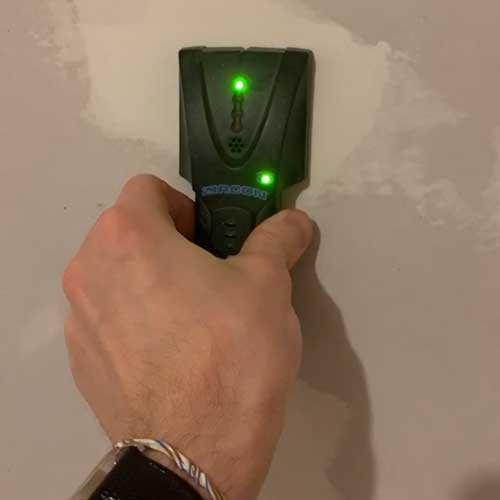
They understand that jobs are going to come up that require some wall hanging… and instead of hammering nails into a wall looking for a stud, they’d rather have a reliable stud finder on hand.
What's in this Guide?
- Here is a List of the Best Stud Finders
- 1. VIVREAL Stud Finder and Wall Scanner
- 2. StudBuddy
- 3. CH Hanson 03040 Magnetic Stud Finder
- 4. Stanley 47-400 Magnetic Stud Finder
- 5. ProSensor 710
- 6. Zircon StudSensor e50 Wall Scanner from Profinder
- 7. Bosch Digital Multi-Scanner GMS120
- 8. DeWalt DCT419S1 Hand-Held Wall Scanner
- 9. ProFinder 5000+
- 10. The Black & Decker BDL190S BullsEye
- Stud Finders Buying Guide
But what is a “good” stud finder? One that finds studs, of course, but more than that it is one that does all the things that you need it to do to make your project go off without a hitch.
As you might have noticed, however, is that there are literally hundreds of models of stud finders. And that doesn’t even take the higher end “wall scanner” models that do so much more. Did you know that new wall finders can scan for plastic pipes? Detect live wiring?
In this guide, I’ll discuss some of the basics of stud finders: how they work, what types are available, and how to determine the features you need. Then I’m going to cover some current finders from a variety of manufacturers. These models cover the spectrum between single-use “find a stud and hang a picture” stud finders to decked-out scanners that can peer through 6″ of concrete wall.
By the end of this guide, you should have a clearer picture of the stud finders available, and what will help you do the job that you need to do.
Here is a List of the Best Stud Finders
1. VIVREAL Stud Finder and Wall Scanner
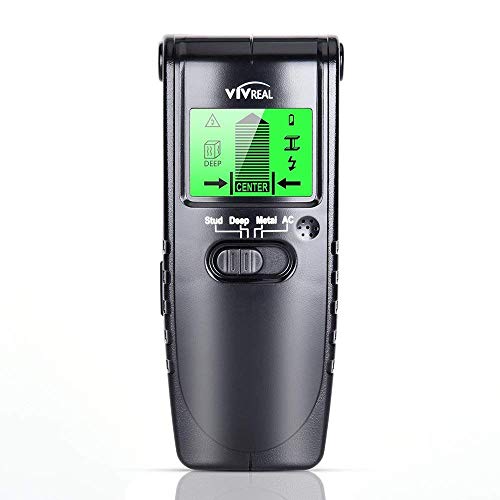
My review: The VIVREAL stud finder is a fully-functional wall scanner that sets itself above and beyond simple magnetic units. The real selling point of this scanner is its 3-in-1 functionality that hits all the sweet spots for DIY and professional users alike.
First, it locates the edges and centers of studs in your wall, which is a huge bonus for people who need accuracy to ensure they are getting maximum support for mounting brackets supporting fixtures like wide-screen TVs or pedestal sinks. The VIVREAL wall scanner also includes a metal scan to catch rebar and thicker metal, and an AC scan to find live AC wires. It also comes with a deep scanning option that works through walls up to 1 1/2 ” deep. The graphical LCD display contains plenty of visual information to tell you not only what has been located (such as studs, live wires, or metal) but also signifies where on the stud the scanner is.
Key Features:
- deep scan for thicker walls
- Very accurate
- Center and edge location
- Locate pipes and AC wires
- LCD display
2. StudBuddy
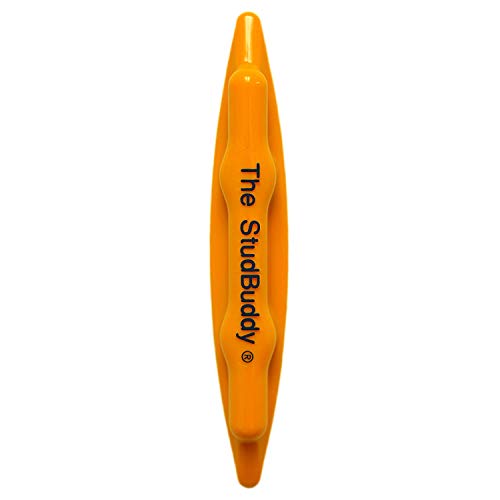
My review: The CH Hanson is simple. The StudBuddy is simpler. This little bullet can signal to you where a stud is, and not much else. This unit uses a magnetic sensor to locate studs, and does so with good accuracy and little calibration. This unit is very inexpensive, but a great addition to a small toolbox when you need something on hand.
Key Features:
- No Batteries Required
- Simple and effective
3. CH Hanson 03040 Magnetic Stud Finder
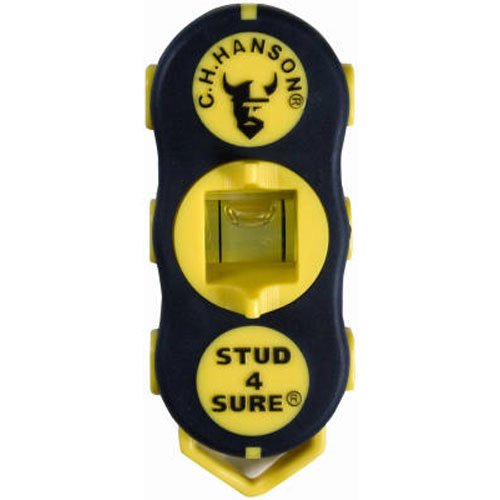
Our Review: This magnetic stud finder is small, compact, and powerful. The perfect stud finder for at-home jobs that need a quick stud location, this unit specializes in finding metal studs and the metal within studs. It doesn’t require batters, and this basic unit includes a built-in leveling bubble that provides easy marking. As a magnetic unit, it might not be as accurate as more advanced models, but with a sub-$10 price range it is the perfect stud finder to throw in your back pocket.
Key Features:
- No batteries required
- Simple and effective
- Built-in leveling
4. Stanley 47-400 Magnetic Stud Finder
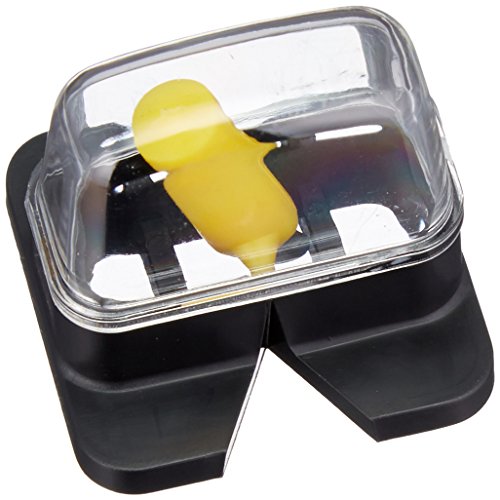
My review: Another magnetic stud finder that’s even simpler than the StudBuddy. Not much to say here in terms of features–this is the definition of a single-use tool. But for many folks that’s exactly what they want or need, and I can’t argue with the fact that if you just need a quick and simple stud finder that fits in your toolbox or back pocket, this fits the bill at a great price point. If you absolutely have to have the smallest, quickest stud finder around, then the 47-400 from Stanley is for you.
Key Features:
- No batteries required
- Inexpensive
- Gets the job done
5. ProSensor 710
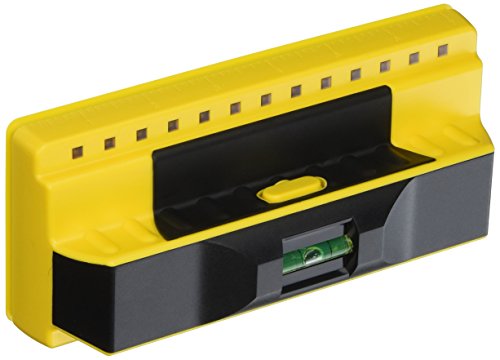
My review: Remember when I talked about wide sensors? The ProSensor 710 is a stud finder that really leans on its wide sensor to get accurate readings across a wall. The ProSensor boasts, first and foremost, excellent accuracy when it comes to finding studs and stud locations, so you have little to worry about when it comes to securely mounting or hanging from the stud center. Also, the ProSensor 710 uses a wide and ergonomic grip with a simple design, which means that it comes more wall space and calibrates easier than other, smaller units. A LED lights up when the finder is over the stud, and its extra-wide sensors make finding stud locations much easier than other models.
This isn’t a fully-functional wall scanner, however—this is a single-purpose tool that gets the job right the first time. Those of you looking for more advanced wall scanning features might find the ProSensor lacking.
Key Features:
- Extra wide scan for accurate edge location
- Simple LED lght
- Lower power usage
6. Zircon StudSensor e50 Wall Scanner from Profinder
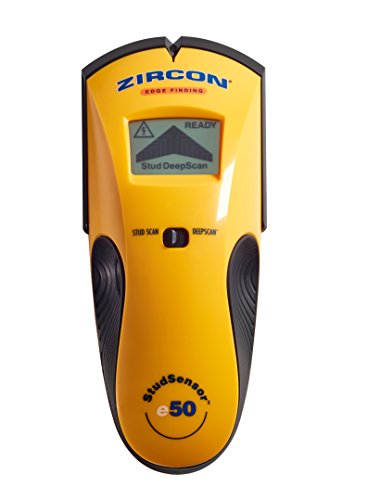
My review: The Zircon StudSensor shares some features with eh ProSensor, namely center and edge finding. This unit can detect the edge and center of wood and metal studs pretty accurately, although perhaps not as accurately as the ProSensor. What the Zircon does offer is features.
This is a fully-formed wall sensor that can sense studs of various materials through various wall thicknesses, while also alerting you to the presence of live AC wires. This is a great unit for those who want something a little more than a magnetic finder without breaking their budgets.
Key Features:
- Finds pipes and AC wires
- Electronic wall scanning
- Less expensive for accurate readings
7. Bosch Digital Multi-Scanner GMS120
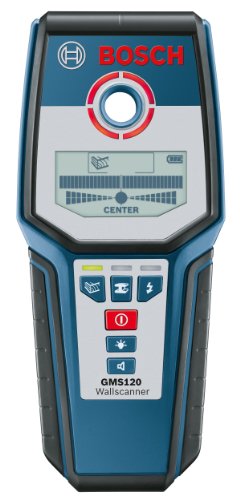
My review: The Bosch Digital MultiScanner, much like the DeWalt, detects several stud types through a variety of materials. While not as powerful as the DeWalt, the Bosch makes up for it with accuracy and portability. The Bosch uses laser detection to locate wood, metal objects (pipes) and live wiring. This unit self-calibrates for different materials, which means that it can handle edge and center finding with ease.
Key Features:
- Comes with a rechargeable 9v battery
- Reads though walls up to 3″ thick
- Costs less than other wall scanners with similar functions
8. DeWalt DCT419S1 Hand-Held Wall Scanner
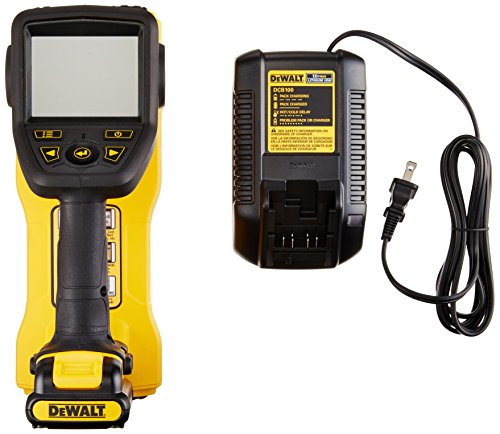
My review: The DeWalt 3.5″ finder is an electronic finder, much like the ProSensor 710 and the CH Hanson 03040. However, the comparison ends there, as this handheld unit is packed to the gills with features. The DeWalt can detect studs of multiple materials–wood, ferrous metal, non-ferrous metal (like copper piping), and anything in between. Furthermore, this device can sense plastic and unshielded electrical wiring behind wall surfaces up to 3″ thick. It can also scan through several different wall types, including concrete and plywood.
What this means is that if there is something in the wall, this unit will find it. That kind of power doesn’t come cheap though… it costs more up front than other units, and carries a rechargeable battery pack that plugs into an outlet.
Key Features:
- Finds plastic pipes and live AC wires
- Reads though walls up to 3″ thick
- Reads though several wall materials, including concrete
9. ProFinder 5000+
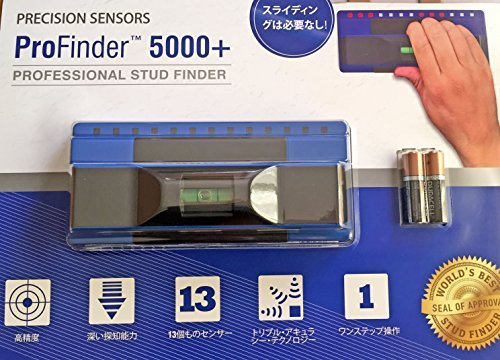
My review: This magnetic stud finder boasts a wide sensor page with more area, which allows for deeper scanning. Using LED lights, this finder will show you when you are over a stud. With 13 sensors built in, running off of two AA batteries, the ProFinder 5000+ boasts big accuracy in a small package. Furthermore, users also get a built-in bubble level and ruler to help with simple marking for hanging and mounting.
This finder is great for everyday needs… with multiple sensors and a wide surface area, it has great accuracy. That accuracy comes at a cost, however, as this model is a bit pricier than others in the same size range. For around $80 you get something that is really great at one thing—finding studs.
If you are willing to put that money up, however, this is a great unit that can serve as the go-to tool when you need it.
Key Features:
- Extra-Wide Scan for Accurate Edge Location
- 13 Sensors for Additional Accuracy
- Lower Power Usage plus Ruler and Spirit Level
10. The Black & Decker BDL190S BullsEye

My review: The Black & Decker BullsEye is a great, small wall scanner that performs several jobs at the same time (a plus for those of us who want multi-purpose tools). This is first and foremost a stud finder capable of detecting wood and metal studs along with live AC wires. It provides users with an easy-to-read LCD screen that tells you exactly what you are finding.
Added to the finding capabilities it already has, the BullsEye also contains patented auto-leveling technology and interior line laser. That means it can locate studs, pinpoint a level orientation to an existing stud, and project a laser level across a wall for hanging and mounting.
Laser levels are some of the handiest tools a DIY can have and coupling one with a stud finder is a great idea that Black & Decker has incorporated into the BullsEye. And, with a reasonable price point, this unit is absolutely one that we recommend.
Key Features:
- Finds Wood, Metal, and AC Wiring
- Auto-Level and Laser Level Projector Included
- Easy to Read LCD Screen
Stud Finders Buying Guide
How Do Stud Finders Work?
Many of us don’t know it, but stud finders have been around since the early 80s. These were simple devices that used magnetic force to sense the presence of a stud behind an already-built wall. Of course, they’ve come a long way in terms of accuracy.
The earliest stud finders were magnetic. These finders used internal magnetic to determine the location of metal located in studs. The theory was that this covered several use contexts—commercial buildings were often built with metal studs, and almost all wooden studs present in residential homes had some sort of metal contained in them.
The magnets contained in the stud finders would locate metal behind existing walls and signal to the operator that a stud was nearby. The more metal contained in the stud, the easier it was to find. As you might expect, this caused several issues:
- Magnets can’t detect wooden studs outside of the metal contained inside them, and because of that locating wooden studs in a home proved difficult.
- These magnetic finders would also pick up metal in the wall that wasn’t in a stud—electrical wiring, water pipes, and so on that would throw off their accuracy.
- These finders couldn’t distinguish between the metal in a stud or the metal from a pipe or wire, which meant that it could be dangerous to drill into a spot triggered by the finder.
Over time, the sensitivity and accuracy of magnetic sensors improved, and new methods of looking for studs behind walls began to revolutionize these devices.
Types of Stud Finders
Now, there are several types of stud finders and sensors on the market that compliment a user’s budget and needs.
- Magnetic finders are still kicking around, and with new magnet technology, they are now fairly accurate. They have the additional benefit of low cost and high usability and fill an important niche for everyday users.
- More modern electronic stud finders utilize electrical signals to determine the location of studs in a wall. These have the additional benefit of being able to detect other metal objects like pipes and AC wires more accurately. Electronic models also provide more accuracy in terms of locating the edge of a stud versus the center of the stud.
- Ultrasonic detectors are much pricier, and use sound waves to map out the inside of the wall. These aren’t typically used in home contexts, as they are heavy-duty units for mapping out the internal makeup of a wall.
The shift from magnetic to electronic to sound also signal an advance in sensitivity and approach. Magnetic units will detect the metal in the studs, whereas electronic and ultrasonic units can detect shifts in density between studs and empty wall cavities while they also detect the metal present.
Truth be told, on the consumer market your primary forms of stud finder sensors are going to be magnetic and electronic–which is completely fine, as both kinds of sensors are more than adequate for day-to-day use. The primary factor in differentiating finder types is the project you have in mind and the needs you have for that project.
Wide Sensors, Deep Sensors, and Center-Finding Units
Stud finder sensors break down further based on the size of the sensor, and its effectiveness in finding parts of the stud itself. Factors like wall depth, the thickness of the material used for the wall, and the sensor type can affect how a stud finder operates, and manufacturers have built stud finder sensors that can mitigate these obstacles.
For example, some stud finders come with larger sensors that cover more space than smaller sensors. With a wider coverage zone, you can cover more area with less movement, and even detect multiple studs at the same time. Wider sensors might (but not always) be more useful in reading thicker walls.
Some more advanced stud finder models also include center-finding capabilities. These allow you to pinpoint the location of the stud edges and the center of the stud. Really good models will have a graphical interface that can show you where you are over the stud (whether it is center or edge), which makes mounting and hanging all the easier.
What Should I Look for in a Stud Finder?
What you should look for in a stud finder depends on your project.
First, what do you really need the unit for? Homeowners hanging pictures don’t necessarily need a heavy-duty stud finder to hammer their nails. Likewise, a commercial contractor needs something with more sensitivity.
Second, what’s your budget? Look for a unit that does what you need it to do within your budget… and don’t spend $50 when all you need is a $5 finder.
Finally, pick a finder that you just like using, and don’t be afraid to exchange it. Several of the models that we’ll cover here have clear and bright view screens, informative icons and intuitive interfaces. Some are made to help you mark off leveled lines with level markers, and some are designed with ergonomic grips.
So, when picking a stud finder, look for something that you need and that helps you do the job you are doing. A good tool shouldn’t stand between you and the success of your project because it is too expensive or complicated.
5 Tips for Picking a Stud Finder.
With that in mind, I suggest several tips for picking out a stud finder:
One: Know your budget. Many of us like to buy new shiny tools for our upcoming projects, but don’t let your stud finder get in the way of something else you might need to buy.
Two: Get something that will last. If you want a stud finder that you can throw in your toolbox and pull out when you need it, then buy something that fills that niche. if you want a high-powered tool that hands on the wall of your workshop, then spend a little more money.
Three: Determine what kind of accuracy you need. Just wanting to hang pictures? Basic magnetic finders might be just what you need.
Four: Don’t get caught up in features. Features are great if you know what they do and they can help you do what you want. Bells and whistles for the sake of having them are just going to add complications to what should be a simple tool.
Five: Find something that self-calibrates. These tools can work great when calibrated…. but some require self-calibration that requires you to know what you are doing. Self-calibrating units not only come out of the box ready to go but will continue to calibrate themselves as you use them.
Simple Units
Simple magnetic stud finders are the bread and butter of the home fixer-upper on a small scale… mounting fixtures, hanging pictures, and other simple household tasks don’t call for much more than knowing where a stud is so you can safely drive a nail or screw there. These units don’t do much, but what they do, they do well, and for a good price. Find studs, hang pictures, and put it in your back pocket when you’re done. These units do their job… and help you do yours.
Residential Versus Commercial Stud Finders
I focused primarily on stud finders that homeowners could use for more-or-less complicated household tasks. And while many of the electronic stud finders in the above listings are powerful, they aren’t necessarily suitable for more commercial or industrial applications.
The truth is that commercial and industrial buildings require a different level of accuracy and usability than residential homes. Coordinating miles and miles of studs, piping, and electrical wiring is difficult enough, and that’s not considering the complexity of many commercial buildings. Professionals in this industry usually look for a tool with more advanced features, and with a sensor accuracy that exceeds the typical needs of homeowners.
For example, Bosch (creator of the Digital Multi-Scanner) also produce the D-TECT 150 Ultra-Wide Scanner. This device collects all the data that the other scanners listed above do, and does so through 6″ of wall. it also boasts an accuracy down to the millimeter and provides information on drill depth and materials that it picks up in a wall. It also boasts an accuracy down to the millimeter and provides information on drill depth and materials that it picks up in a wall. When it comes to high-impact industrial building, many contractors find that they need extra strength and accuracy, and are willing to pay more money.
Beyond that, your commercial applications are going to go beyond simply locating studs. The Leica Geosystems 3D Disto is more than a wall scanner–it is a 3D imaging system that allows contractors to model building plans into CAD models.
At some level, the price of such scanners puts them out of reach of homeowners. But serious builders and contractors who are looking for tools that can help them easily do their job should consider investing in a unit with more commercial uses.
Can I Find Studs Without a Scanner?
Short answer–sure, but I don’t recommend it.
The longer answer is a little more involved. Before stud finders were even a thing, construction workers used the “tap” method to locate studs. Simply put, they tapped on different sections of a wall and used the sound to determine if a section was hollow or connected to a stud. A hollow section of wall was obviously stud-free, and with their knowledge of stud spacing workers could more or less figure out where to drive nails. You can learn more about how to find will studs manually here.
And that’s fine. I’m not going to criticize something that works for others. At the same time, if I was a homeowner and a contractor needed to hang support for a heavy fixture, I wouldn’t trust the fact that they started tapping on the wall.
The truth is that stud finders are going to keep your fixtures and pictures safely on your walls by allowing you to do your job right the first time. Tapping on walls to determine stud location is going to require that you know exactly how a hollow wall will sound and that you have a good idea of how studs are spaced. More importantly, tapping doesn’t really give you a sense of where wires and pipes might be… which is, of course, a huge safety concern.
Conclusion
I’ve covered a cross-section of stud finders here that more or less displays the range of finders available. From back-pocket magnetic finders to radar-equipped commercial models, it’s safe to say that there should be a model for most any user we can think of.
The most important aspect of picking a finder, however, is you. Think about when you go to the hardware store to pick up a stud finder because you need to hang a picture. More likely than not, you are going to see several magnetic and electronic models ranging from $5 to $100 (if not more, depending on your store). That’s a pretty big gap, and something as simple as grabbing a stud finder just got a lot more complicated.
So, your first, and most important, rule of thumb is “how am I going to use this”? Power users who have to have the best tools available might think that they need top-of-the-line power tools no matter the job. They then end up with a $100 stud finder they use once and never pick up again.
Likewise, DIYers who want to cut corners on every aspect of their project might buy the cheapest finder available simply because they can’t imagine paying out for something so simple. Then they see that the accuracy they needed isn’t represented in the money they invested in their tools, and following that they run into problems.
Homeowners–if you just want to hang a picture, then $5-$20 on a stud finder is more than accurate. Magnetic sensors will do exactly what you need, and you won’t have to worry about drilling into drywall and nothing else.
But if you’re mounting that new 45″ TV, or placing a new pedestal sink into your guest bathroom remodel, then realize that a bad mounting can cause a lot of problems. That’s where you want accuracy and control, and locating studs is a crucial part of that project.
I say that your tools should match your job. Don’t overspend, but don’t be afraid to get the tool that you need.

Hello, my name is Chris and I was born and raised in Western Pennsylvania. I’m an engineer with experience in medical technology, steel and materials, and nuclear power industries. I have been with my current employer for more than 5 years developing digital control systems for nuclear power plants.
I’m also a homeowner with a growing range of home renovation experience. My goal is to take all my technical knowledge and first-hand experience and translate it into high-quality content to support all of your home guide needs. Whether it be step-by-step guides, technical consultation, or product reviews, my aim is to make all your home projects a great success!
